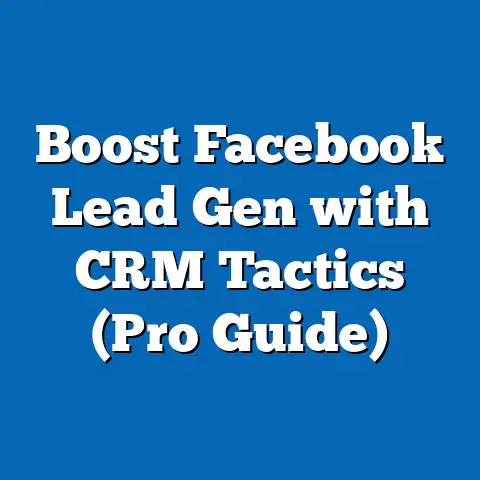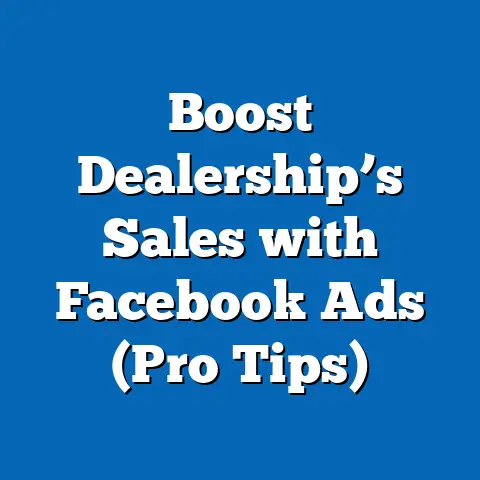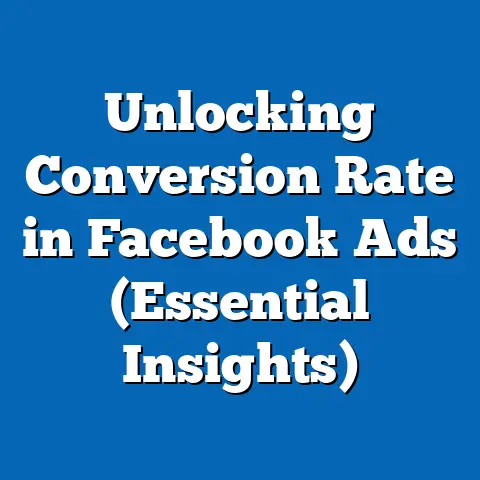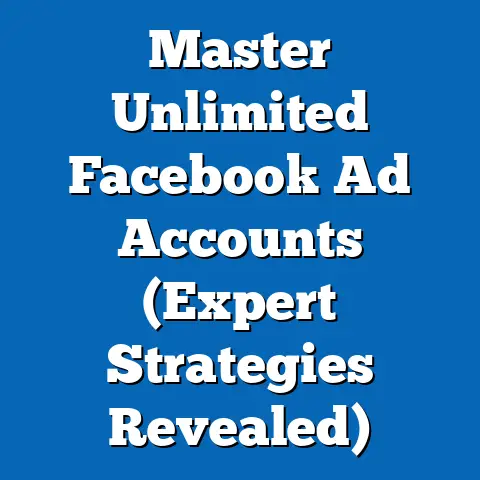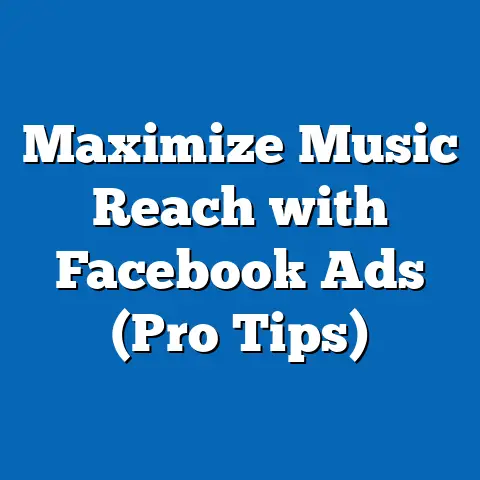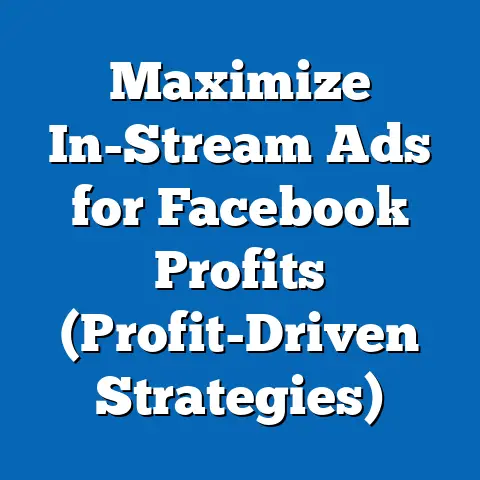Master Facebook Ads Changes (Essential Insights Revealed)
Advertising, at its core, is about connecting with people in a way that resonates. While the fundamental principles remain constant, the landscape where we connect—the digital world—is in perpetual motion. Facebook Ads, a cornerstone of modern marketing, is no exception. It’s a dynamic platform, constantly evolving to meet the ever-changing needs of both users and advertisers. Understanding these shifts isn’t just about keeping up; it’s about seizing opportunities to connect more effectively and achieve sustained success.
I’ve been navigating the Facebook Ads ecosystem for over a decade, and I’ve seen it transform from a relatively simple platform into the sophisticated, data-rich environment it is today. I remember the early days when targeting options were basic, and creative was often an afterthought. Now, we have access to granular audience segmentation, advanced AI-powered optimization, and a plethora of ad formats to choose from.
But with great power comes great responsibility, and navigating these changes can feel like trying to build a sandcastle during a hurricane. That’s why I’ve put together this guide. It’s not just about listing the latest features; it’s about providing the essential insights you need to master these changes and turn them into a competitive advantage. We’ll delve into the evolution of Facebook Ads, dissect its structure, examine key recent changes, and explore future trends. My goal is to arm you with the knowledge and strategies to not only survive but thrive in the ever-evolving world of Facebook advertising.
Key Takeaways:
- Adaptability is Key: The only constant in Facebook Ads is change. Embrace it and develop a mindset of continuous learning and adaptation.
- Data-Driven Decisions: Rely on data analysis and A/B testing to inform your strategy and optimize your campaigns.
- Audience Understanding: Deeply understand your target audience and tailor your messaging and creative to resonate with them.
- Stay Informed: Keep up-to-date with the latest platform updates, industry trends, and best practices.
1. The Evolution of Facebook Ads
To truly understand the present state of Facebook Ads, we need to take a trip down memory lane. The platform’s journey from its humble beginnings to the advertising powerhouse it is today is a testament to its adaptability and commitment to innovation.
From Simple Ads to Sophisticated Targeting
Facebook Ads launched in 2007, initially offering basic text ads that were a far cry from the visually rich and highly targeted ads we see today. The early days were about casting a wide net, hoping to reach a relevant audience. However, the introduction of “Facebook Connect” and the subsequent explosion of user data transformed the platform into a goldmine for targeted advertising.
I remember the excitement when Facebook first introduced demographic targeting options. Suddenly, we could reach users based on age, location, and interests. This was a game-changer, allowing us to create more relevant and effective campaigns. But that was just the beginning.
Over the years, Facebook rolled out a series of groundbreaking features, including:
- Custom Audiences: The ability to upload customer lists and target existing customers on Facebook.
- Lookalike Audiences: The power to find new customers who share similar characteristics to your existing customers.
- Pixel Tracking: The implementation of a tracking pixel to measure conversions and optimize campaigns.
- Advanced Ad Formats: The introduction of video ads, carousel ads, and collection ads, providing advertisers with more creative options.
Each of these updates represented a significant leap forward, empowering marketers to create more personalized and impactful advertising experiences.
Reflecting Broader Trends
The evolution of Facebook Ads isn’t happening in a vacuum. It’s a direct reflection of broader trends in digital marketing and consumer behavior. As consumers have become more sophisticated and demanding, Facebook has responded by providing advertisers with the tools to deliver more relevant and engaging experiences.
For example, the rise of mobile usage has led to a greater emphasis on mobile-optimized ad formats and targeting options. The increasing demand for video content has fueled the growth of video ads on Facebook. And the growing concerns about privacy have prompted Facebook to introduce stricter data privacy regulations and more transparent ad targeting options.
Real-World Example:
Consider the evolution of retargeting. In the early days, retargeting was a relatively simple process of showing ads to users who had visited your website. Today, retargeting is far more sophisticated, allowing you to segment users based on their behavior on your website, personalize ads based on their past purchases, and even target users who have abandoned their shopping carts. This level of personalization is only possible because of the advancements in Facebook Ads and the increasing availability of user data.
Key Takeaways:
- Facebook Ads has evolved significantly over the years, from simple text ads to sophisticated targeting options and advanced ad formats.
- These changes reflect broader trends in digital marketing and consumer behavior.
- Understanding the history of Facebook Ads can help you appreciate the current state of the platform and anticipate future changes.
2. Understanding Facebook Ads Structure
Before diving deeper into the changes, it’s crucial to have a solid understanding of the fundamental structure of Facebook Ads. Think of it as the architectural blueprint for your advertising campaigns.
Campaign, Ad Set, and Ad: The Building Blocks
The Facebook Ads structure is organized into three distinct levels:
- Campaign: The highest level, where you define your overall advertising objective (e.g., brand awareness, website traffic, lead generation).
- Ad Set: The middle level, where you define your target audience, budget, schedule, and ad placements.
- Ad: The lowest level, where you create the actual ad creative (e.g., image, video, text) that will be shown to your target audience.
Think of it like this: the campaign is the overall goal, the ad set is the strategy for achieving that goal, and the ad is the execution of that strategy.
The Importance of Each Component
Each component plays a critical role in the success of your Facebook Ads campaigns.
-
Campaign: Choosing the right campaign objective is essential for optimizing your ads for the desired outcome. For example, if you want to drive traffic to your website, you should choose the “Traffic” objective. If you want to generate leads, you should choose the “Lead Generation” objective.
-
Ad Set: This is where the magic happens. The ad set determines who sees your ads, when they see them, and where they see them. Careful audience targeting, strategic budgeting, and effective ad placement are all crucial for maximizing your ROI.
-
Ad: Your ad is the face of your campaign. It’s what users see and interact with. Compelling ad copy, high-quality visuals, and a clear call-to-action are essential for capturing attention and driving conversions.
Campaign: Choosing the right campaign objective is essential for optimizing your ads for the desired outcome. For example, if you want to drive traffic to your website, you should choose the “Traffic” objective. If you want to generate leads, you should choose the “Lead Generation” objective.
Ad Set: This is where the magic happens. The ad set determines who sees your ads, when they see them, and where they see them. Careful audience targeting, strategic budgeting, and effective ad placement are all crucial for maximizing your ROI.
Ad: Your ad is the face of your campaign. It’s what users see and interact with. Compelling ad copy, high-quality visuals, and a clear call-to-action are essential for capturing attention and driving conversions.
Interacting to Achieve Goals
The campaign, ad set, and ad work together to achieve your advertising goals. The campaign sets the overall direction, the ad set defines the target audience and budget, and the ad delivers the message. By carefully optimizing each component, you can create highly effective Facebook Ads campaigns that drive results.
Example:
Let’s say you want to promote a new product launch.
- Campaign: You would choose the “Conversions” objective to optimize your ads for sales.
- Ad Set: You would define your target audience based on demographics, interests, and behaviors. You would also set your budget and schedule.
- Ad: You would create an ad with a compelling image or video showcasing your new product, along with persuasive ad copy and a clear call-to-action (e.g., “Shop Now”).
By carefully optimizing each component, you can create a Facebook Ads campaign that effectively promotes your new product and drives sales.
Key Takeaways:
- The Facebook Ads structure is organized into three levels: campaign, ad set, and ad.
- Each component plays a critical role in the success of your campaigns.
- Understanding how these components interact is essential for creating effective Facebook Ads.
3. Key Changes in Facebook Ads
Now, let’s dive into the heart of the matter: the key changes that have shaped Facebook Ads in recent years. These changes have significant implications for how we approach Facebook advertising, and it’s crucial to understand them to stay ahead of the curve.
Updates to Ad Formats, Targeting Options, and Algorithms
Facebook is constantly experimenting with new ad formats, refining its targeting options, and tweaking its algorithms. Here are some of the most significant changes:
-
Advantage+ Campaign Budget: This feature uses AI to distribute your budget across ad sets in real-time, optimizing for the best performance. While it can be effective, it also requires careful monitoring to ensure that your budget is being allocated efficiently. I’ve found that Advantage+ can be a great time-saver for larger campaigns, but it’s important to understand how it works and to keep a close eye on performance.
-
AI-Powered Optimization: Facebook is increasingly relying on artificial intelligence to optimize ad delivery and improve performance. This includes features like automated bidding, dynamic creative optimization, and smart retargeting. While AI can be a powerful tool, it’s important to remember that it’s not a magic bullet. You still need to provide the AI with the right data and guidance to achieve the best results.
Advantage+ Campaign Budget: This feature uses AI to distribute your budget across ad sets in real-time, optimizing for the best performance. While it can be effective, it also requires careful monitoring to ensure that your budget is being allocated efficiently. I’ve found that Advantage+ can be a great time-saver for larger campaigns, but it’s important to understand how it works and to keep a close eye on performance.
AI-Powered Optimization: Facebook is increasingly relying on artificial intelligence to optimize ad delivery and improve performance. This includes features like automated bidding, dynamic creative optimization, and smart retargeting. While AI can be a powerful tool, it’s important to remember that it’s not a magic bullet. You still need to provide the AI with the right data and guidance to achieve the best results.
Implications of Privacy Regulations
Privacy regulations like GDPR (General Data Protection Regulation) and CCPA (California Consumer Privacy Act) have had a profound impact on Facebook Ads. These regulations have placed stricter limits on data collection and ad targeting, requiring advertisers to obtain explicit consent from users before collecting and using their data.
This has led to several changes in Facebook Ads, including:
- Limited Data Availability: Advertisers have less access to user data, making it more challenging to target ads effectively.
- Increased Transparency: Facebook has increased transparency around ad targeting, allowing users to see why they are seeing specific ads.
- Emphasis on First-Party Data: Advertisers are increasingly relying on first-party data (data collected directly from their customers) to target ads.
Impact of Changes in User Behavior
Changes in user behavior and preferences also have a significant impact on ad strategies. For example, the shift towards video content has led to a greater emphasis on video ads on Facebook. The increasing use of mobile devices has prompted advertisers to optimize their ads for mobile. And the growing popularity of ephemeral content (like Stories) has led to the development of new ad formats for Stories.
I’ve noticed a significant increase in the effectiveness of video ads over the past few years. People are simply more engaged with video content than with static images or text. However, it’s important to create high-quality videos that are optimized for the Facebook platform. This means creating short, attention-grabbing videos that are visually appealing and relevant to your target audience.
Key Takeaways:
- Facebook Ads is constantly evolving, with updates to ad formats, targeting options, and algorithms.
- Privacy regulations like GDPR and CCPA have had a significant impact on data collection and ad targeting.
- Changes in user behavior and preferences are also driving changes in ad strategies.
4. Essential Insights for Mastering Facebook Ads
Now that we’ve covered the key changes in Facebook Ads, let’s discuss the essential insights you need to master these changes and create successful campaigns.
A/B Testing and Data Analysis
A/B testing and data analysis are the cornerstones of effective Facebook advertising. A/B testing allows you to compare different versions of your ads to see which performs best. Data analysis allows you to track your campaign performance, identify areas for improvement, and make data-driven decisions.
I’m a firm believer in the power of A/B testing. I’ve seen countless examples of how small changes to ad copy, visuals, or targeting can have a significant impact on performance. The key is to test one variable at a time, track the results carefully, and iterate based on the data.
Practical Tip:
Start with a clear hypothesis. Before you start A/B testing, define what you want to test and what you expect to happen. For example, you might hypothesize that using a different headline in your ad copy will increase click-through rates. By having a clear hypothesis, you can better interpret the results of your A/B test and make more informed decisions.
Audience Segmentation Techniques
Effective audience segmentation is crucial for delivering relevant and engaging ads to your target audience. By segmenting your audience based on demographics, interests, behaviors, and other factors, you can create more personalized ads that resonate with each segment.
Custom Audiences and Lookalike Audiences:
Custom Audiences allow you to target your existing customers on Facebook. This is a powerful way to re-engage customers, promote new products, and drive repeat purchases. Lookalike Audiences allow you to find new customers who share similar characteristics to your existing customers. This is a great way to expand your reach and find new prospects who are likely to be interested in your products or services.
Example:
Let’s say you run an e-commerce store that sells athletic apparel. You could create a Custom Audience of your existing customers and target them with ads promoting new arrivals. You could also create a Lookalike Audience based on your existing customers to find new prospects who are interested in fitness and athletic apparel.
Compelling Ad Copy and Visuals
Compelling ad copy and visuals are essential for capturing attention and driving conversions. Your ad copy should be clear, concise, and persuasive. Your visuals should be high-quality, visually appealing, and relevant to your target audience.
Tips for Creating Effective Ad Copy:
- Focus on the benefits: Highlight the benefits of your product or service, rather than just the features.
- Use strong calls to action: Tell users what you want them to do (e.g., “Shop Now,” “Learn More,” “Sign Up”).
- Keep it short and sweet: People have short attention spans, so get to the point quickly.
Tips for Creating Effective Visuals:
- Use high-quality images and videos: Avoid blurry or pixelated images.
- Make them visually appealing: Use colors, fonts, and layouts that are eye-catching.
- Make them relevant: Ensure that your visuals are relevant to your target audience and your product or service.
Key Takeaways:
- A/B testing and data analysis are crucial for optimizing your campaigns.
- Effective audience segmentation is essential for delivering relevant ads.
- Compelling ad copy and visuals are necessary for capturing attention and driving conversions.
5. Future Trends in Facebook Ads
Looking ahead, what can we expect from Facebook Ads in the future? While it’s impossible to predict the future with certainty, we can make some educated guesses based on current trends and industry forecasts.
The Rise of AI and Automation
Artificial intelligence and automation are poised to play an even bigger role in Facebook Ads in the future. We can expect to see more AI-powered features that automate tasks, optimize campaigns, and improve performance.
Potential Impact:
- Smarter Bidding: AI will be used to optimize bids in real-time, ensuring that you’re always paying the right price for your ads.
- Automated Creative Optimization: AI will be used to automatically generate and test different ad creatives, ensuring that you’re always using the most effective visuals and copy.
- Personalized Ad Experiences: AI will be used to personalize ad experiences based on user behavior and preferences, creating more engaging and relevant ads.
Augmented Reality and Immersive Experiences
Augmented reality (AR) and immersive experiences are also likely to play a bigger role in Facebook Ads in the future. AR ads allow users to interact with your products in a virtual environment, creating a more engaging and immersive experience.
Potential Impact:
- Virtual Try-Ons: AR ads could allow users to virtually try on clothing, accessories, or makeup before making a purchase.
- Interactive Product Demonstrations: AR ads could allow users to interact with your products in a virtual environment, learning more about their features and benefits.
- Immersive Brand Experiences: AR ads could be used to create immersive brand experiences that transport users to a different world.
Evolving Consumer Preferences
As consumer preferences continue to evolve, Facebook Ads will need to adapt to meet their changing needs. We can expect to see a greater emphasis on:
- Privacy: Consumers are increasingly concerned about privacy, so Facebook will need to continue to prioritize data privacy and transparency.
- Authenticity: Consumers are increasingly skeptical of traditional advertising, so Facebook will need to focus on creating authentic and engaging experiences.
- Personalization: Consumers expect personalized experiences, so Facebook will need to provide advertisers with the tools to deliver more relevant and targeted ads.
Key Takeaways:
- AI and automation are poised to play an even bigger role in Facebook Ads.
- Augmented reality and immersive experiences are likely to become more prevalent.
- Facebook Ads will need to adapt to evolving consumer preferences.
Conclusion
Mastering Facebook Ads changes is not just about keeping up; it’s about seizing opportunities to connect more effectively and achieve sustained success in digital marketing. The platform is constantly evolving, and it’s crucial to stay informed about the latest changes and trends.
By understanding the evolution of Facebook Ads, dissecting its structure, examining key recent changes, and exploring future trends, you can arm yourself with the knowledge and strategies to not only survive but thrive in the ever-evolving world of Facebook advertising.
Key Insights to Remember:
- Adaptability is Key: The only constant in Facebook Ads is change. Embrace it and develop a mindset of continuous learning and adaptation.
- Data-Driven Decisions: Rely on data analysis and A/B testing to inform your strategy and optimize your campaigns.
- Audience Understanding: Deeply understand your target audience and tailor your messaging and creative to resonate with them.
- Stay Informed: Keep up-to-date with the latest platform updates, industry trends, and best practices.
The world of Facebook Ads is a dynamic and exciting one, filled with opportunities for those who are willing to learn, adapt, and innovate. So, embrace the challenge, stay curious, and keep pushing the boundaries of what’s possible. Your success in Facebook advertising depends on it.

